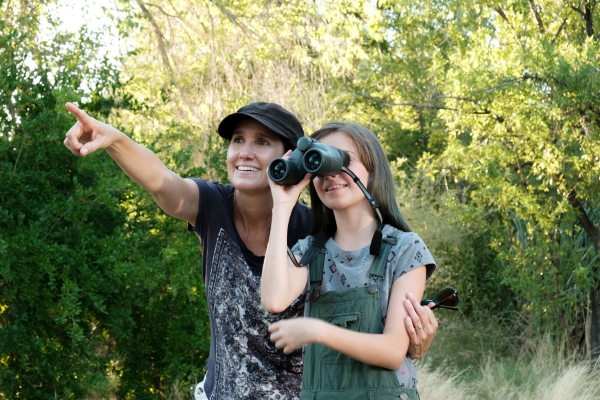
While there is always something interesting to see, you will find the greatest numbers of birds at the refuge from early November to late January. In the spring and fall, migratory bird species are moving through the refuge, resulting in high numbers of species.
Winter (mid-November through late January)
Thousands of snow geese, Ross’s geese, and sandhill cranes spend the night in water to protect themselves from predators. Near dawn, the geese take off en masse in search of fields throughout the Middle Rio Grande Valley to feed in for the day. Smaller groups of sandhill cranes then leave the safety of the water for the same reason. Check the sunrise time and stop in our visitor center to learn the most recent roosting and feeding sites, as they can change through the winter.
In addition to viewing cranes and geese and many species of ducks, you can drive the auto tour loop or hike the trails and see hawks, eagles, blackbirds, ravens, coots, and other birds along with occasional mammals, such as mule deer, coyotes, and jackrabbits. Check in with the visitor center staff for recent sightings.
Spring (mid-February through mid-May)
The wetlands that were home to thousands of ducks, geese, and cranes all winter are slowly emptied of water in the spring, providing prime feeding grounds for migrating sandpipers, stilts, plovers, dunlins, curlews, avocets, and twenty other shorebird species. Spring wildflowers add a bit more color to the landscape, and greater roadrunners dart across and alongside the auto tour loop and Highway 1 in search of sluggish lizards and snakes.
Spring is also when flycatchers, vireos, and a dozen species of warblers filter through, either as a rest stop on migration or as they determine the best locations for their nesting territories on the refuge.
Summer (mid-May through mid-September)
Summer is the time to see the colorful antics of black-chinned, calliope, broad-tailed, and rufous hummingbirds. The flowers of spring transition to the fruits of summer, especially in the desert arboretum. Also look for the many young birds moving around the refuge. Some, like the quail, scurry around in long lines of a dozen or more.
Mornings and evenings are good times to view wildlife in the heat of the summer – most creatures will seek shade in the middle of the day. Near waterways are good places to search for wildlife and signs of wildlife (such as tracks).
Fall (mid-September through mid-November)
Late season sunflowers are a colorful contrast to the red-winged blackbirds that swoop and dart through the grasses. The first cranes and geese typically show up at the end of October, during which time coyotes, mule deer, and javelina are moving through open fields as well. Wild turkeys begin moving to the northern part of the refuge to join up with other family groups in separate male and female roosting flocks.
The Dabbler Deck or Willow Deck are good places to take a break and search for ducks dabbling in the water for food, especially the northern shovelers and northern pintails.
